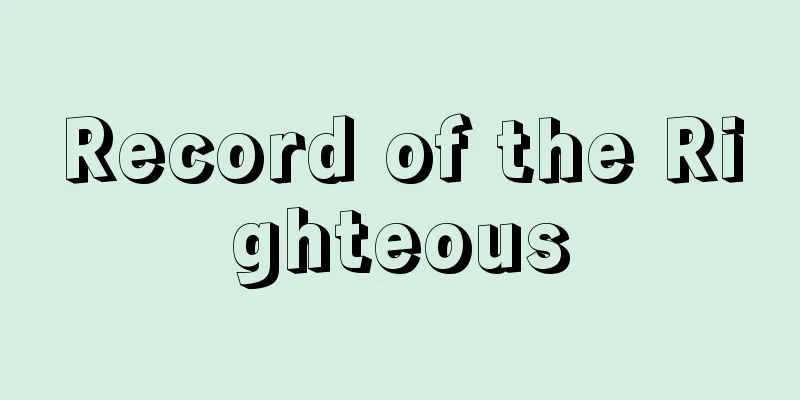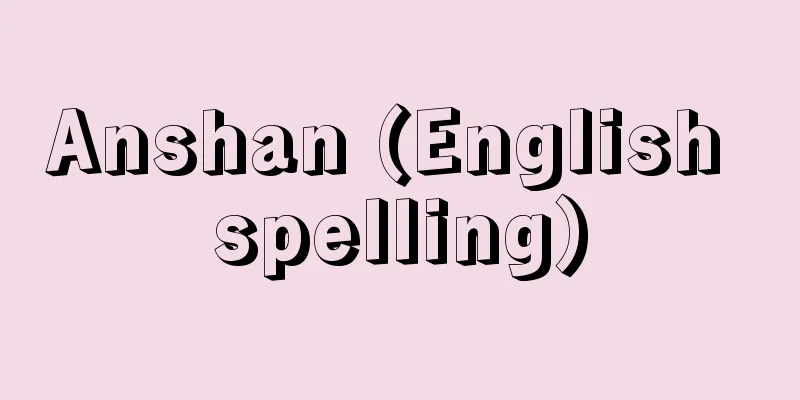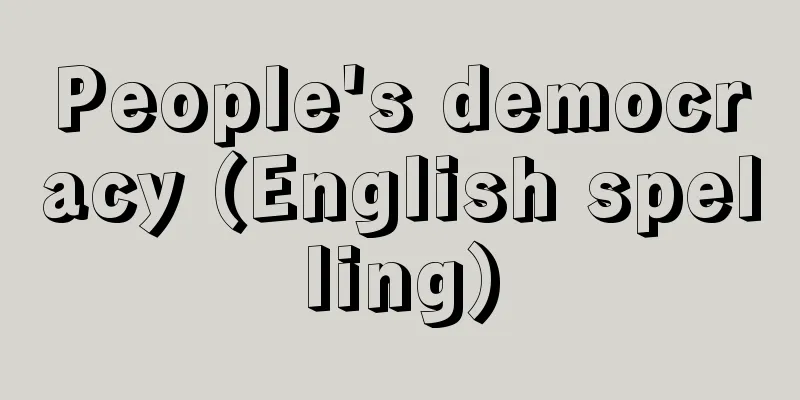Enka - Enka

|
A type of Japanese popular song. It has been used since the mid-Meiji period as a counterpart to "speech" to express opinions through song. Expressing ideas through song has been a tradition since ancient times, but songs that rely on melodies such as "Counting Songs" or "Dodoitsu," such as "Minken Rural Songs" by Ueki Emori and "Yoshiya Bushi" by Yasuoka Michitaro, are not called enka. Therefore, the first enka song was "Oppekepe" by Kawakami Otojiro. This song, created at the end of 1889 (Meiji 22), immediately captured the hearts of Kyoto citizens as soon as it was performed at a comedy hall in Shinkyogoku, Kyoto. "Oppekepe," which preaches in simple terms the expansion of freedom and civil rights without criticizing government policies, can be said to be the result of Kawakami's long-running anti-authority struggle, and the following year, when Kawakami's troupe traveled east with their soshi-shibai (a traditional Japanese theater group), it began to become popular in Yokohama and Tokyo as well. It reached its peak after June 1891. This song, which places importance only on the content and rhythm of the lyrics and has no set melody, is called a declamation in musical terms. At a time when there were almost no popular songs apart from hauta (traditional Japanese songs) and folk songs, "Oppekepe," which anyone could easily hum, created a new field of entertainment for the people. Among the soshi hanging around Tokyo, some began to imitate Kawakami and sing loudly in the streets, while also selling this songbook to make a living. Similar songs such as "Yattsukero-bushi," "Kimbo-bushi," and "Dynamite Don" were written, but because some of the lyrics criticized the government, they were often suppressed by the authorities. Some groups gave the name "enka" to these soshi songs, but the general public called them "yomiuri" or "soshi-uta." However, the majority of soshi were students, and because they played songs such as "Hōkai-bushi" and "Nissin Negotiations Break" on the koto, so soshi songs came to be known more as "shosei-bushi." At that time, the behavior of shokunin (students) who tried to win the favor of young girls by wearing black kimonos, straw hats, and light makeup caused a big stir as a social issue. It was during this period that Soeda Azenbo wrote socialist songs. In the 1910s, songs by Kaminaga Ryogetsu of Tokyo and Nakabayashi Takeo of Osaka were popular, with favorites such as "Zangetsu Issei," "Matsu no Koe," and "Hototogisu." When the violin was eventually introduced, audiences were drawn to the novel instrument and began to surround Shosei-bushi. In the mid-Taisho period, when songs such as "Ikakebushi" and "Shichirigahama no Adanami" (Mashiroki Fuji no Mine) became popular throughout the country, Shosei-bushi singers began to be called "enka poets," and, coupled with the power of film, songs such as "Sendou Kouta" and "Kago no Tori" became all the rage. In the 1930s, when recorded songs became popular, Shosei-bushi disappeared and "pop songs" rose to prominence, and Shoji Taro, Otomaru, Uehara Bin and others were born as "pop singers". In addition, there were many talented lyricists who were exclusive to record companies, such as Saijo Yaso, Saeki Takao, and Fujita Masato, and many other talented composers, such as Koga Masao, Koseki Yuji, and Omura Nosho. Then, around 1960 (Showa 35), "enka" was revived along with the word "enka". Many singers, including Misora Hibari, Shimakura Chiyoko, Kasuga Hachiro, Minami Haruo and others, appeared, and their singing voices shook the souls of the people, forming a golden age. As foreign pop music became popular, popular songs with a strong Japanese rhythm were called enka, but after the first oil crisis (1973), popular songs were divided into enka and new music. When we look at the changes in the term, lyrics, and singing style, we can define today's enka as a voice that is rooted in Japanese soil. Even after the 1970s, singers such as Kitajima Saburo, Mori Shinichi, Itsuki Hiroshi, Hosokawa Takashi, Miyako Harumi, Suizenji Kiyoko, Yashiro Aki, Kobayashi Sachiko, and Ishikawa Sayuri have been active and supported enka, but the position of enka in the popular song genre has declined relatively due to the further diversification of popular songs and the aging of enka fans. [Yoshihiro Kurata] Source: Shogakukan Encyclopedia Nipponica About Encyclopedia Nipponica Information | Legend |
|
日本の流行歌の一種。歌によって意見を述べるという意味で、「演説」に対応することばとして明治中期から使用された。思想を歌に託して表明することは古くから行われてきたが、植木枝盛(えもり)作『民権田舎歌(いなかうた)』や安岡道太郎作『よしや武士(ぶし)』のように、「数え歌」や「どどいつ」の旋律に頼るものは演歌とよばない。したがって演歌の嚆矢(こうし)は川上音二郎作『オッペケペー』となる。1889年(明治22)の暮れにつくられたこの歌は、京都・新京極の寄席(よせ)で公開されるや、たちまち京都市民の心をとらえた。政府の施策を非難することなく、自由と民権の伸張を平易に説く『オッペケペー』は、多年にわたる川上の反権力闘争の成果といえるが、翌年に壮士芝居を率いて東上した川上一座の公演によって、横浜や東京でも流行し始めた。絶頂に達するのは1891年6月以降である。歌詞の内容とリズムをたいせつにするだけで、一定の旋律をもたないこの歌は、音楽的にはデクラメーションdeclamationという。端唄(はうた)や俗曲以外、はやり歌が皆無に近かった当時の民衆にとって、だれもが容易に口ずさめる『オッペケペー』は、民衆娯楽の新分野を形成することになった。 東京にたむろする壮士のなかには、川上をまねて街頭で放歌高吟するかたわら、この歌本を売って生活の糧(かて)を得る者が現れる。『ヤッツケロ節』『欽慕節(きんぼぶし)』『ダイナマイトドン』など同類の歌もつくられたが、政府を弾劾する歌詞もあって、しばしば官憲の弾圧を受けた。こうした壮士の歌に「演歌」の名を冠する一団もあったが、世間では一般に「読売」とか「壮士歌(うた)」とよんだ。ところが壮士の大半は書生であり、『法界節(ほうかいぶし)』や『日清(にっしん)談判破裂して』を月琴(げっきん)で流したので、壮士歌はむしろ「書生節」という名称で親しまれるようになった。そのころ、黒地の着物に編笠(あみがさ)をかぶり、薄化粧を施して娘たちの歓心を買おうとする書生たちの行為は、社会問題として大きな波紋をよんだ。添田唖蝉坊(そえだあぜんぼう)が、社会主義的な歌をつくったのもこの時代である。 1910年代になると、東京の神長瞭月(かみながりょうげつ)と大阪の中林武雄の歌がもてはやされ、『残月一声』『松の声』『不如帰(ほととぎす)』などが好まれた。やがてバイオリンが用いられると、目新しいこの楽器にひかれ、書生節の周辺を聴衆が取り巻くことになる。大正中期、『一かけ節』や『七里ヶ浜の仇浪(あだなみ)』(真白き富士の嶺(ね))が全国に浸透するころ、書生節の歌手は「演歌師」といわれ始め、映画の力とも相まって『船頭小唄(こうた)』や『籠(かご)の鳥』が一世を風靡(ふうび)した。 1930年代になってレコード歌謡に人気が集まると、書生節は消滅して「歌謡曲」が台頭し、東海林(しょうじ)太郎、音丸(おとまる)、上原敏(びん)らが「流行歌手」として誕生してくる。またレコード会社専属の作詞家として西条八十(やそ)、佐伯孝夫(さえきたかお)、藤田まさと、作曲者として古賀政男(まさお)、古関裕而(こせきゆうじ)、大村能章(のうしょう)ほか多士済々。そして1960年(昭和35)前後に「艶歌(えんか)」ということばとともに「演歌」が復活する。美空ひばりをはじめ、島倉千代子、春日(かすが)八郎、三波春夫ら、枚挙にいとまがないほど多数の歌手が出現し、その歌声は民衆の魂を揺さぶって黄金時代を形成した。外国のポップスの流行につれて、こぶしのきいた日本調の歌謡曲を演歌とよんだわけであるが、第一次石油ショック(1973)を境に歌謡曲は演歌とニューミュージックに二分された。こうした用語の変遷や歌詞ないしは歌い方に注目するとき、今日の演歌は、日本的な土壌に立脚した歌声だと定義づけることができよう。1970年代以降も、北島三郎、森進一、五木ひろし、細川たかし、都はるみ、水前寺清子、八代亜紀、小林幸子、石川さゆりらの歌手が活躍し演歌を支えているが、歌謡曲のさらなる多様化、演歌ファン層の高齢化などにより、歌謡曲分野に占める演歌の位置付けは相対的に低下している。 [倉田喜弘] 出典 小学館 日本大百科全書(ニッポニカ)日本大百科全書(ニッポニカ)について 情報 | 凡例 |
Recommend
Taimin Tachibana - Taimin Tachibana
A small tree of the Ardisiaceae family found in mo...
Indo-Parthian tribes
… [Susumu Sato] 【India】 A branch of the Parthians...
Profit - Equity
[Sound] Eki (Kanji) Yaku (Go) [Reading] Masu, more...
Kickboxing
A fighting sport similar to boxing. It is a sport...
Heat of mixing - kongounetsu
The amount of heat generated or absorbed when two ...
Outdoor Advertising - Okugaikokoku
A general term for advertising materials that are...
Kappa - Kappa
[1] [noun] (a variation of " kappa" ) 1....
Azil culture
A culture from the early Mesolithic period in West...
Cone pepper
…var. cerasiforme (cherry pepper) is a variety cu...
Sanetoshi Saionji - Saionji Sanetoshi
Year of death: 1389.7.28 Year of birth: Kenmu 2 (1...
"Fair" - Gigeki
...However, the actual performance was not a succ...
Civil Procedure Rules
Based on the power to make rules granted by Articl...
Tanaka Michimaro
Year of death: Tenmei 4.10.4 (1784.11.16) Year of ...
Shadow meal - Shadow meal
A meal offered at the home of a family member who...
Emmy von N.
One of the cases reported by S. Freud in Studies o...









